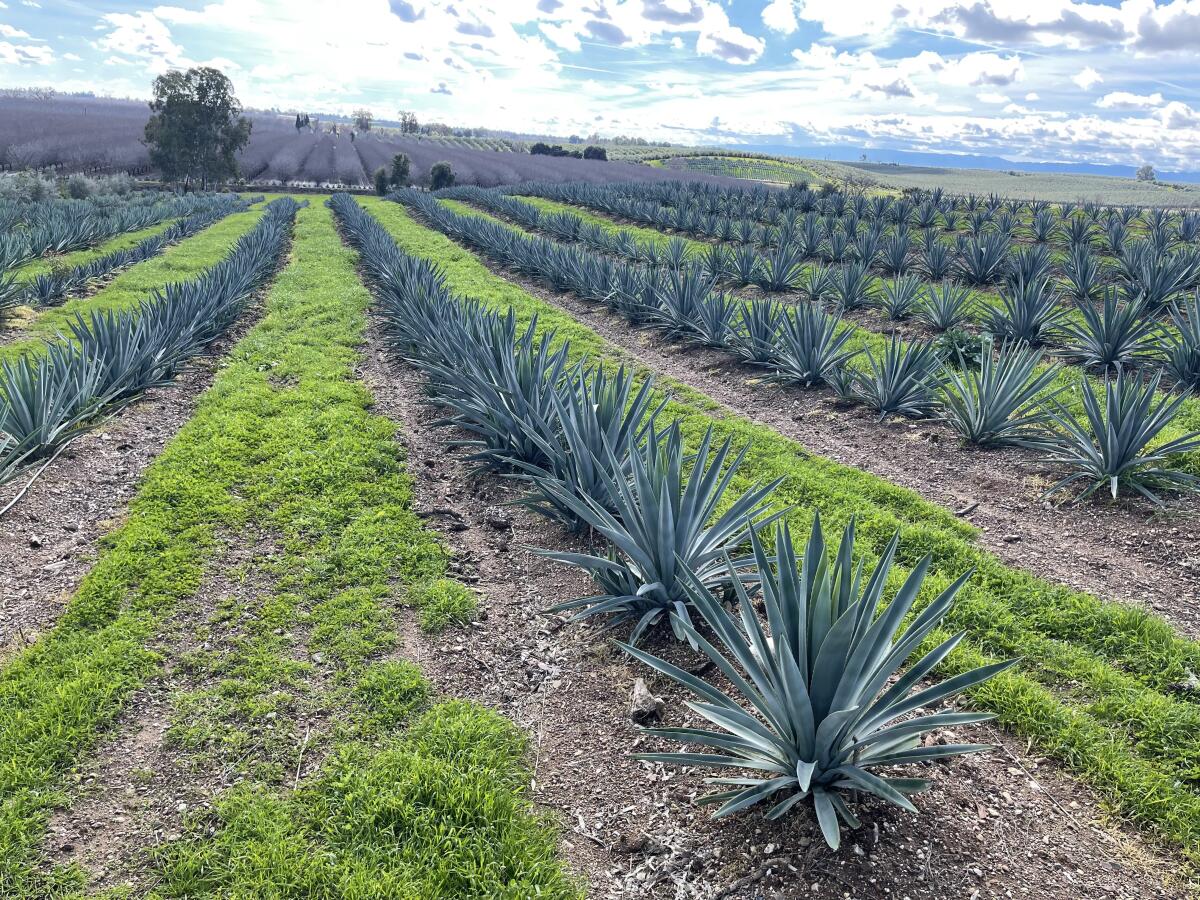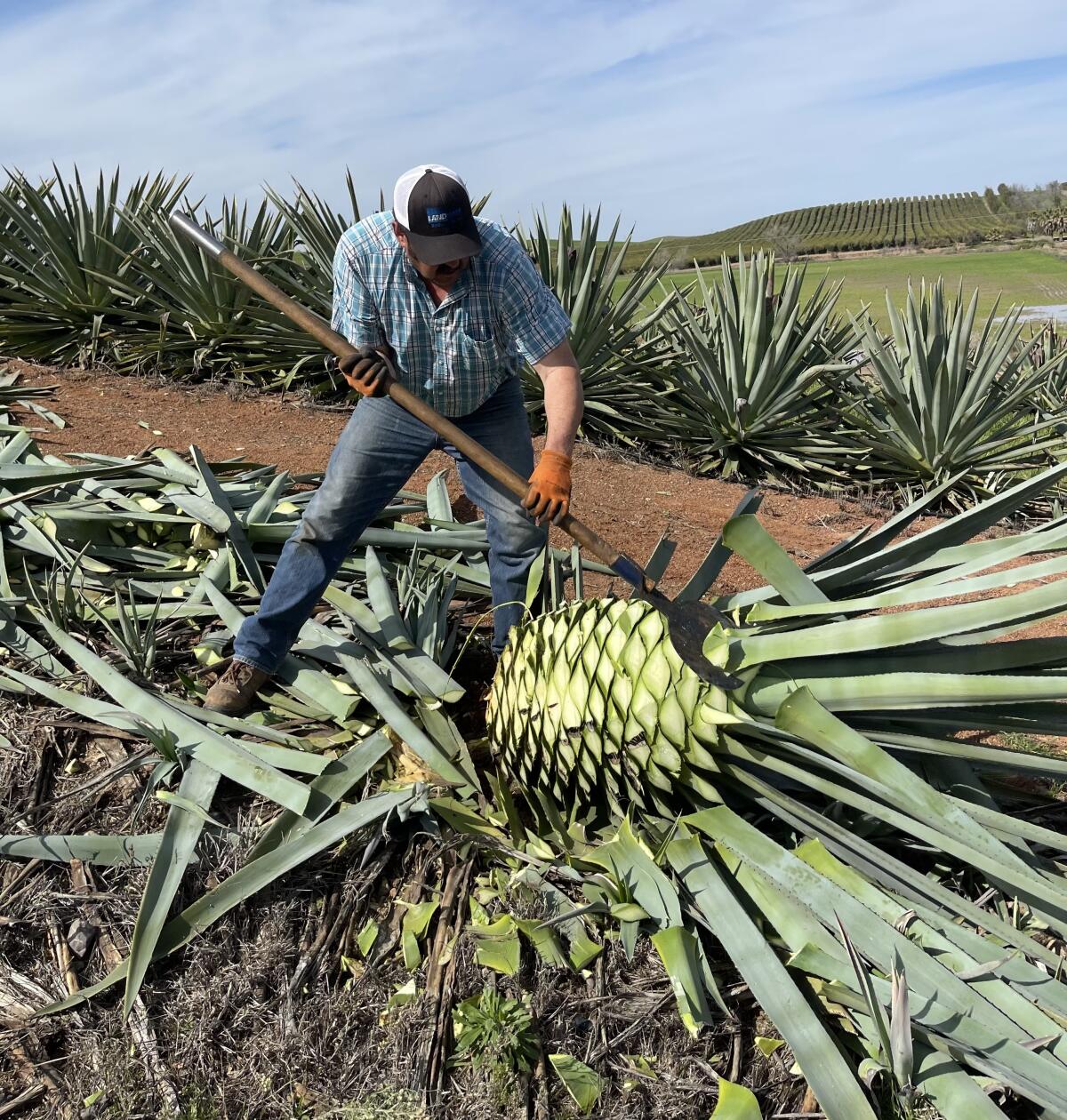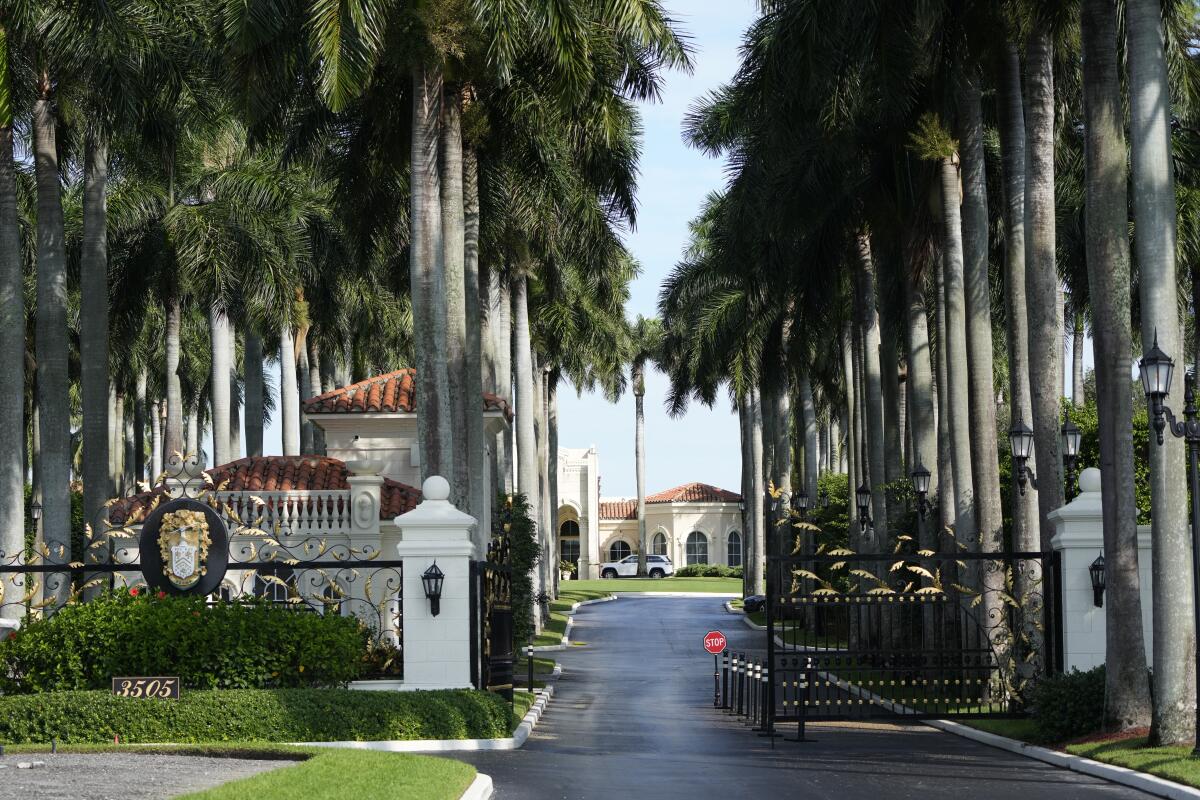Can agave help solve California’s agricultural dilemma? Some farmers are betting big

- Share via
Good morning, it’s Tuesday, Sept. 17. Here’s what you need to know to start your day.
- Some California farmers are banking on a “magical crop” in response to drought and climate change.
- California shifts from record heat and fire to a rapid cooldown — with the possibility of early-season snow.
- Food Bowl begins Friday, with chef demos, cookbook signings and more. Here’s a look at what’s on the menu for this year’s festival of eating and drinking.
Sign up for Essential California
The most important California stories and recommendations in your inbox every morning.
You may occasionally receive promotional content from the Los Angeles Times.
Can agave help solve California’s agricultural dilemma? Some farmers are betting big
California’s fertile farmland — much of it in the San Joaquin Valley — feeds the nation. But all that farming takes a lot of water, which continues to dwindle as the state faces the harsh realities of climate change.
With less water to go around and hotter conditions threatening many legacy crops, farmers are fallowing more acres and losing hundreds of millions in revenue. In a study from UC Merced, researchers estimated the state lost 752,000 acres of irrigated farmland in 2022.
Switching to less-thirsty crops could cut agricultural water consumption in the state by as much as 93%, researchers with UC Santa Barbara and the NASA Jet Propulsion Laboratory reported earlier this year.
Now some farmers are betting big on what they believe could be part of the solution: agave.
The pointy succulents have a deep, rich history in Mexico, where they’re cultivated and distilled into tequila, mezcal and other spirits. But until recently, they had not been grown commercially in the Golden State.

A small but growing group of farmers and distillers have been planting the seeds of what they hope will be a rich California market for agave spirits and other products — and an adaptive response to climate change and drought.
One of those farmers is Stuart Woolf, whose family has been farming in Fresno County since the 1940s. He was not the first to plant agave, but he has planted the most so far — roughly 400,000 plants on 340 acres.
“We’re in a highly productive area,” Woolf told me last week. “We have really great soils — we just don’t have enough water.”
Woolf said climate change and water restrictions meant he had to explore alternative uses for some of his family’s farmland. As he studied up on drought-tolerant options, he became agave curious.
So he invested in an initial “proof of concept,” planting about a dozen varieties in a test plot to see how well they’d grow. They did well, he said.
Woolf decided to focus on espadín, the variety commonly used in mezcal. And he opted to “go big on the front end,” importing about 600,000 plants but selling about a third to other growers interested in what’s blossomed into a Central Valley succulent experiment.
Climate change threatens the production of water-intensive Central Valley staples including almonds and pistachios. But agave’s water savings are considerable, as Woolf explained:
“Almonds use about 50 inches of water per acre per year — a little over four feet. Pistachios use about 35 inches per acre per year. … We use about 30 inches per acre per year to grow a crop of tomatoes. Right now, agave is using about 3 inches per acre per year.”
Woolf told me he views the investment as “a hedge against warmer climate going forward.”
“I’ll still be able to farm this property, even if I had zero water,” he said. “These plants, they may not grow as fast, but they’re not going to die.”
Still, there are some challenges. Woolf described the learning curve in understanding what kind of diseases or pests could pose threats to the plants. Weeds are one nuisance that crews have to remove by hand for now because there are no registered herbicides for the new commercial crop. And there’s another troublemaker with a sweet tooth.
“Gophers love agave. It’s this dense plant that is full of starches and sugars,” he shared. “One day you’re looking at these plants and you think, ‘Oh my God, it’s beautiful.’ And the next day, [it’s] like ‘Caddyshack.’”
Growers believe agave could be a game changer, with the potential to take off like California’s wine industry.
I spoke with Craig Reynolds, who founded and leads the California Agave Council, a trade association formed in 2022. The group is made up of about 80 growers and craft distillers in the state.
The industry is “still in a very infant stage,” but he sees major potential for the “magical crop” to thrive in soil that would otherwise go untilled.
“Climate change creates opportunities,” Reynolds said. “We’re the bread basket of the world. We’re going to let that land just sit there or put solar panels on it? Why don’t we figure out something else to do with that land that’s viable?”

The group has already lobbied for state legislation to help the fledging industry. State Assemblymember Cecilia Aguiar-Curry (D- Winters) has written two bills in recent years that have passed the Legislature with bipartisan support. The first set specific production standards for agave spirits. Another this year seeks to establish a California Agave Commission to take “collective action in the broad fields of research, education, promotion, and marketing” of the emerging industry.
There are a few California agave spirits already on the market (they can’t be called tequila or mezcal because those names refer to regional spirits in Mexico), though Reynolds notes it will be a long time before U.S. ventures take up any real space on the shelves.
But given that U.S. sales of tequila and mezcal have surpassed whiskey and could overtake vodka, Reynolds said the potential for California agave far exceeds its place as a “boutique specialty crop.”
“To have an impact for California agriculture and for climate resilience, it needs to be big,” he said.
Agave’s use goes beyond just a strong drink.
Ron Runnebaum, an associate professor at UC Davis’ Department of Viticulture and Enology, has been working with Woolf, Reynolds and others to research agave’s commercial use in California, which has mostly been uncharted.
Although its use for spirits may represent the biggest financial opportunity, Runnebaum noted the plants’ potential as a source of biofuel. And fibers from agave leaves have a variety of uses, including dish scubbers, menstrual pads and car parts.
In the coming years, he and fellow researchers will be working to understand genetic diversity in agave varieties, along with their susceptibility to viruses and how well they respond to different levels of watering and fertilizers.
It’s an experiment that he said would “hopefully be very interesting not only for growers but also for consumers.”
It’ll be a lesson in patience for everyone, since it can take six to nine years for agave plants to reach maturity and be harvested. If they’re used for spirits, it can take a few months to a year after distillation for the product to be aged, bottled and ready to hit shelves and bars.
Today’s top stories

The suspect in an apparent assassination attempt against Trump waited near the former president’s golf course for almost 12 hours, cellphone data show.
- The suspect, Ryan Wesley Routh, was charged with possession of a firearm by a convicted felon and possession of a firearm with an obliterated serial number. He faces up to 15 years in prison if convicted of the first charge, plus an additional five years if convicted of the second charge, officials said.
- The motives of the suspect have not been revealed. But Trump blamed the “rhetoric of Biden and Harris.”
- Back-to-back assassination attempts on Trump have historic echoes. In September 1975, President Ford escaped two attempts on his life in California.
Sean “Diddy” Combs was arrested amid a federal sex-trafficking probe.
- The hip-hop mogul was arrested Monday night at a New York hotel without incident, sources told The Times. The U.S. attorney for the Southern District of New York is expected to release more information today.
- Law enforcement sources told The Times earlier this year that Combs was the subject of a sweeping inquiry into sex-trafficking allegations that resulted in a federal raid in March at his estates in Los Angeles and Miami.
L.A. Metro’s plan to expand service ahead of the 2028 Olympics could be imperiled.
- Labor advocates have sued the transit agency, saying Metro violated its own policy in a $730-million order of new subway cars meant to replace much of its aging fleet and run on the D Line extension to West Los Angeles.
- A delay in getting new rail cars could leave passengers stuck with the dingier older cars as hundreds of thousands of people descend on the region for the Games.
A flier promoting a homelessness ballot measure leaves out a key fact: It’s a tax increase.
- A flier arriving in mailboxes throughout Los Angeles County doesn’t mention the ballot measure would increase the homeless sales tax to half a cent to help fund services and housing.
- The measure comes amid heightened concerns over homelessness. But a poll conducted during the summer found voters were lukewarm on the ballot measure.
- Meanwhile, a nonprofit helped conceive California’s homeless housing program — and then left string of failed projects.
More big stories
- California shifts from record heat and fire to a rapid cooldown — with the possibility of early-season snow.
- Google will invest in satellites and AI to better detect wildfires, starting as early as next year.
- George Gascón and Nathan Hochman agreed to debate next month in the final stretch of the L.A. County D.A. race.
- In “liberal” San Francisco, the sole progressive vying for mayor is an underdog.
- California may join several other states in regulating pharmaceutical brokers, whom many policymakers blame for the soaring cost of prescription drugs.
- Three small earthquakes struck north of Malibu just four days after a magnitude 4.7 quake was reported in the same area.
Get unlimited access to the Los Angeles Times. Subscribe here.
Commentary and opinions
- The rhetoric of Harris and Biden isn’t what’s sparking political violence, columnist Jonah Goldberg writes.
- The principles underlying the Trump-Vance smear of Haitian immigrants can be found in Nazi-era antisemitic propaganda, columnist Michael Hiltzik writes.
- Trump talks tough on Russia now, but as president he bowed to Putin, columnist LZ Granderson writes.
- Authoritarianism and hatred are no match for a politics of love, writes Ruth Ben-Ghiat, author of “Strongmen: Mussolini to the Present.”
- High-stakes politics have us seeking normalcy, writes Carlos Sánchez, a professor of philosophy at San José State University. But what if uncertainty and crisis are the norm?
Today’s great read
How a memorial to WWII sex slaves ignited a battle in Berlin. Similar fights over memorials to the “comfort women” have played out elsewhere, including Southern California. But the dispute has special resonance in Germany.
How can we make this newsletter more useful? Send comments to [email protected].
For your downtime
Going out
- 👩🍳 Food Bowl begins this Friday, with chef demos, cookbook signings and more. Here’s a look at what’s on the menu for this year’s festival of eating and drinking.
- 🍽️ Chef Josiah Citrin’s Mélisse in Santa Monica celebrates its 25th anniversary at a tough time for restaurants.
- 🎸 Jane’s Addiction abruptly canceled its reunion tour after an onstage fight between singer Perry Farrell and guitarist Dave Navarro.
Staying in
- 👻 A ghost story about new motherhood? A TV writer’s debut novel explores the female psyche.
- 🌊 Richard Powers’ latest epic, “Playground,” moves between the troubled ecosystem of the oceans and the fraught ethics and dislocations of the virtual world.
- 📖 Pedro Almodóvar’s first book, like his movies, blends reality and fiction.
- 🥗 Here’s a recipe California Heat spicy peanut noodles.
- ✏️ Get our free daily crossword puzzle, sudoku, word search and arcade games.
And finally ... a great photo
Show us your favorite place in California! Send us photos you have taken of spots in California that are special — natural or human-made — and tell us why they’re important to you.

Today’s great photo is from Theo Moreno of Cambria: the expansive Hearst Castle, which features more than 20,000 pieces of artwork.
Theo writes: “It is now a California State Park, and, if you get the right guide, the story is amazing. The pools alone SCREAM California!”
Have a great day, from the Essential California team
Ryan Fonseca, reporter
Amy Hubbard, deputy editor, Fast Break
Check our top stories, topics and the latest articles on latimes.com.
Sign up for Essential California
The most important California stories and recommendations in your inbox every morning.
You may occasionally receive promotional content from the Los Angeles Times.






